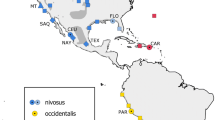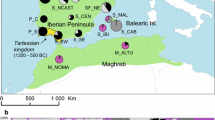Abstract
The West Asian stripe-necked terrapin Mauremys caspica is widespread throughout the Middle East—a region for which only few phylogeographic studies are available. Due to landscape alteration, pollution and intensification of water management, M. caspica is increasingly threatened. However, genetic diversity among and within populations is poorly known, impeding the identification of management units. Using a nearly rangewide sampling, we analyzed 14 microsatellite loci and mtDNA sequences in order to gain insight into the population structure and history of M. caspica. In agreement with a previous study, we found two clusters of mitochondrial haplotypes, with one cluster distributed in the east and the other in the west of the range. However, our microsatellite data suggested a more pronounced geographical structuring. When null alleles were coded as recessive with structure 2.3.2, three clusters were revealed, with one cluster matching roughly the range of the western mitochondrial cluster, and the composite ranges of the two other microsatellite clusters correspond to the distribution of the eastern mitochondrial cluster. Naïve structure analyses without correction for null alleles were congruent with respect to the two eastern microsatellite clusters, but subdivided the western cluster into two units, with an additional geographical divide corresponding to the ‘Anatolian diagonal’—a well-known high mountain barrier impeding exchange between western and eastern taxa. In naïve analyses, the westernmost microsatellite cluster (from Central Anatolia) is quite isolated from the others, and its distinctness is also supported by fixation indices resembling the values among the other three clusters. One of the two eastern clusters is distributed in the Caucasus region plus Iran, and terrapins from Saudi Arabia and Bahrain constitute the second eastern cluster, supporting the view that these endangered populations are native. Coalescent-based analyses of our microsatellite data reveal for all four clusters bottlenecks 4,000–20,000 years ago, suggesting that climatic fluctuations of the Late Pleistocene and Holocene played an important role in shaping current genetic diversity. We propose that each of the four identified clusters, including the Central Anatolian one, should be treated as a distinct management unit. The presence of non-native terrapins in the animal trade of Bahrain highlights the danger of genetic pollution of the endangered Arabian populations. Further sampling is needed to elucidate the situation in southern and central Iran and Iraq. Our results confirm that genetic data do not support the validity of any of the three morphologically defined subspecies of M. caspica, and we propose that their usage be abandoned.




Similar content being viewed by others
References
Anderson, S. C. (1979). Synopsis of the turtles, crocodiles, and amphisbaenians of Iran. Proceedings of the California Academy of Sciences, 4th Series, 41, 501–528.
Anon. (2003). Conservation Assessment and Management Plan (CAMP) for the Fauna of Arabia, 23-26 February 2003. Fourth International Conservation Workshop for the Threatened Fauna of Arabia. Final Report. Sharjah: Breeding Center for Endangered Arabian Wildlife.
Ansell, S. W., Stenøien, H. K., Grundmann, M., Russell, S. J., Koch, M. A., Schneider, H., et al. (2011). The importance of Anatolian mountains as the cradle of global diversity in Arabis alpina, a key arctic-alpine species. Annals of Botany, 108, 241–252.
Arctander, P. (1988). Comparative studies of avian DNA by restriction fragment polymorphism analysis. Journal of Ornithology, 129, 205–216.
Bannikov, A. G. (1951). Materialy k poznaniyu biologii kavkazskikh cherepakh. Uchenye zapiski Moskovskogo gorodskogo pedagogicheskogo instituta W. P. Potemkina, 18, 129–167.
Bayazit, M., & Avci, I. (1997). Water resources of Turkey: potential, planning, development and management. International Journal of Water Resources Development, 13, 443–452.
Beaumont, P. (1998). Restructuring of water usage in the Tigris-Euphrates basin: The impact of modern water management policies. In J. Albert, M. Bernhardsson, & R. Kenna (Eds.), Transformations of Middle Eastern Natural Environments: Legacies and Lessons (pp. 168–186). New Haven: Yale School of Forestry and Environmental Studies.
Beaumont, M. A. (1999). Detecting population expansion and decline using microsatellites. Genetics, 153, 2013–2029.
Biricik, M., & Turğa, Ş. (2011). Description of an Euphrates softshell turtle (Rafetus euphraticus) nest from the Tigris River (SE Turkey). Salamandra, 47, 99–102.
Chikhi, L., Sousa, V., Luisi, P., Goossens, B., & Beaumont, M. A. (2010). The confounding effects of population structure, genetic diversity and the sampling scheme on the detection and quantification of population size changes. Genetics, 186, 983–995.
Clement, M., Posada, D., & Crandall, K. A. (2000). tcs: a computer program to estimate gene genealogies. Molecular Ecology, 9, 1657–1660.
Davis, P. H. (1971). Distribution patterns in Anatolia with particular reference to endemism. In P. H. Davis, P. C. Harper, & I. C. Hedge (Eds.), Plant Life of South-West Asia (pp. 15–27). Edinburgh: Royal Botanic Garden.
Ekim, T., & Güner, A. (1986). The Anatolian diagonal: fact or fiction? Proceedings of the Royal Society of Edinburgh, 89B, 69–77.
Evanno, G., Regnaut, S., & Goudet, J. (2005). Detecting the number of clusters of individuals using the software structure: a simulation study. Molecular Ecology, 14, 2611–2620.
Excoffier, L., Laval, G., & Schneider, S. (2005). arlequin (version 3.0): an integrated software package for population genetics data analysis. Evolutionary Bioinformatics Online, 1, 47–50.
Falush, D., Stephens, M., & Pritchard, J. K. (2003). Inference of population structure using multilocus genotype data: linked loci and correlated allele frequencies. Genetics, 164, 1567–1587.
Falush, D., Stephens, M., & Pritchard, J. K. (2007). Inference of population structure using multilocus genotype data: dominant markers and null alleles. Molecular Ecology Notes, 7, 574–578.
Fritz, U., & Havaš, P. (2007). Checklist of chelonians of the world. Vertebrate Zoology, 57, 149–368.
Fritz, U., & Wischuf, T. (1997). Zur Systematik westasiatisch-südosteuropäischer Bachschildkröten (Gattung Mauremys). Zoologische Abhandlungen, Staatliches Museum für Tierkunde Dresden, 49, 223–260.
Fritz, U., Auer, M., Bertolero, A., Cheylan, M., Fattizzo, T., Hundsdörfer, A. K., et al. (2006). A rangewide phylogeography of Hermann’s tortoise, Testudo hermanni (Reptilia: Testudines: Testudinidae): implications for taxonomy. Zoologica Scripta, 35, 531–543.
Fritz, U., Ayaz, D., Buschbom, J., Kami, H. G., Mazanaeva, L. F., Aloufi, A. A., et al. (2008). Go east: phylogeographies of Mauremys caspica and M. rivulata – discordance of morphology, mitochondrial and nuclear genomic markers and rare hybridization. Journal of Evolutionary Biology, 21, 527–540.
Fritz, U., Ayaz, D., Hundsdörfer, A. K., Kotenko, T., Guicking, D., Wink, M., et al. (2009). Mitochondrial diversity of European pond turtles (Emys orbicularis) in Anatolia and the Ponto-Caspian Region: multiple old refuges, hotspot of extant diversification and critically endangered endemics. Organisms, Diversity and Evolution, 9, 100–114.
Garstecki, T., & Amr, Z. (2011). Biodiversity and Ecosystem Management in the Iraqi Marshlands—Screening Study on Potential World Heritage Nomination. Amman: IUCN.
Gasperetti, J., Stimson, A. F., Miller, J. D., Ross, J. P., & Gasperetti, P. R. (1993). Turtles of Arabia. Fauna of Saudi Arabia, 13, 170–367.
Glaubitz, J. C. (2004). convert: a user friendly program to reformat diploid genotypic data for commonly used population genetic software packages. Molecular Ecology Notes, 4, 309–310.
Gmelin, S. G. (1774). Reise durch Rußland zur Untersuchung der drey Natur-Reiche. Dritter Theil. Reise durch das nordliche Persien, in den Jahren 1770, 1771, bis im April 1772. St. Petersburg: Kayserliche Academie der Wissenschaften.
Goudet, J. (1995). fstat (version 1.2): a computer program to calculate F-statistics. Journal of Heredity, 86, 485–486.
Guicking, D., Joger, U., & Wink, M. (2009). Cryptic diversity in a Eurasian watersnake (Natrix tessellata, Serpentes: Colubridae): evidence from mitochondrial sequence data and nuclear ISSR-PCR fingerprinting. Organisms, Diversity and Evolution, 9, 201–214.
Gvoždík, V., Moravec, J., Klütsch, C., & Kotlík, P. (2010). Phylogeography of the Middle Eastern tree frogs (Hyla, Hylidae, Amphibia) as inferred from nuclear and mitochondrial DNA variation, with a description of a new species. Molecular Phylogenetics and Evolution, 55, 1146–1166.
Hall, T. A. (1999). bioedit: a user friendly biological sequence alignment editor and analysis program for Windows 95/98/NT. Nucleic Acids Symposium Series, 41, 95–98.
Harmancioğlu, N., Alpaslan, N., & Boelee, E. (2001). Irrigation, health and environment: a review of literature from Turkey. Colombo: International Water Management Institute (IWMI).
Hashemi, S. A. R., Eskandary, G. H., & Ansary, H. (2012). Biomass of fish species in the Shadegan wetland, Iran. Research Journal of Recent Sciences, 1, 66–68.
Hrbek, T., & Meyer, A. (2003). Closing of the Tethys Sea and the phylogeny of Eurasian killifishes (Cyprinodontiformes: Cyprinodontidae). Journal of Evolutionary Biology, 16, 17–36.
Hubisz, M. J., Falush, D., Stephens, M., & Pritchard, J. K. (2009). Inferring weak population structure with the assistance of sample group information. Molecular Ecology Resources, 9, 1322–1332.
Kinzelbach, R. (1986). Recent records of the Nile softshell turtle, Trionyx triunguis, and of the Euphrates softshell turtle, Trionyx euphraticus, in the Middle East. Zoology in the Middle East, 1, 83–87.
Librado, P., & Rozas, J. (2009). dnasp v5: a software for comprehensive analysis of DNA polymorphism data. Bioinformatics, 25, 1451–1452.
Palsbøll, P. J., Bérubé, M., & Allendorf, F. W. (2011). Identification of management units using population genetic data. Trends in Ecology & Evolution, 22, 11–16.
Preusser, F. (2009). Chronology of the impact of Quaternary climate change on continental environments in the Arabian Peninsula. Comptes Rendus Geoscience, 341, 621–632.
Pritchard, J. K., Stephens, M., & Donnelly, P. (2000). Inference of population structure using multilocus genotype data. Genetics, 155, 945–959.
Randi, E. (2008). Detecting hybridization between wild species and their domesticated relatives. Molecular Ecology, 17, 285–293.
Rousset, F. (2008). genepop’007: a complete reimplementation of the genepop software for Windows and Linux. Molecular Ecology Resources, 8, 103–106.
Spinks, P. Q., Shaffer, H. B., Iverson, J. B., & McCord, W. P. (2004). Phylogenetic hypotheses for the turtle family Geoemydidae. Molecular Phylogenetics and Evolution, 32, 164–182.
Storz, J. F., & Beaumont, M. A. (2002). Testing for genetic evidence of population expansion and contraction: an empirical analysis of microsatellite DNA variation using a hierarchical Bayesian model. Evolution, 56, 156–166.
Vamberger, M., Stuckas, H., & Fritz, U. (2011). Fifteen microsatellite markers for the stripe-necked terrapin Mauremys caspica (Testudines: Geoemydidae) and cross-amplification tests in M. rivulata. Conservation Genetics Resources, 3, 87–89.
van Oosterhout, C., Hutchinson, W. F., Wills, D. P. M., & Shipley, P. (2004). micro-checker: software for identifying and correcting genotyping errors in microsatellite data. Molecular Ecology Notes, 4, 535–538.
Weir, B. S., & Cockerham, C. C. (1984). Estimating F-statistics for the analysis of population structure. Evolution, 38, 1358–1370.
Acknowledgments
Thanks for support go to Matjaž Gregorič, Michael Mende, Anke Müller, Ole Reuter, and Mario Vargas-Ramírez. Markus Auer, Daniel Frynta, Mario Herz and Pavel Široký donated samples. We are indebted to His Highness Sheikh Dr. Sultan bin Mohammed Al Qasimi, Supreme Council Member and Ruler of Sharjah, and Hana Al Suwaidi, Chief Executive Officer of EPAA, Sharjah, for the opportunity to study Arabian terrapins. M.V. was funded by a PhD fellowship of the German Academic Exchange Service (DAAD; A/09/91179). Laboratory work was funded by the German Research Foundation (DFG; FR 1435/7-1) and field work in Turkey by the Scientific and Technological Research Council of Turkey (TÜBITAK; TBAG-2402 103 T189).
Author information
Authors and Affiliations
Corresponding author
Electronic supplementary material
Below is the link to the electronic supplementary material.
ESM 1
(PDF 202 kb)
Rights and permissions
About this article
Cite this article
Vamberger, M., Stuckas, H., Ayaz, D. et al. Conservation genetics and phylogeography of the poorly known Middle Eastern terrapin Mauremys caspica (Testudines: Geoemydidae). Org Divers Evol 13, 77–85 (2013). https://doi.org/10.1007/s13127-012-0102-6
Received:
Accepted:
Published:
Issue Date:
DOI: https://doi.org/10.1007/s13127-012-0102-6




